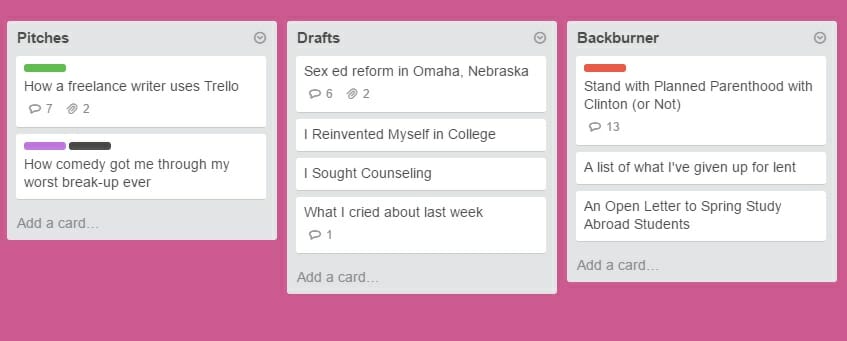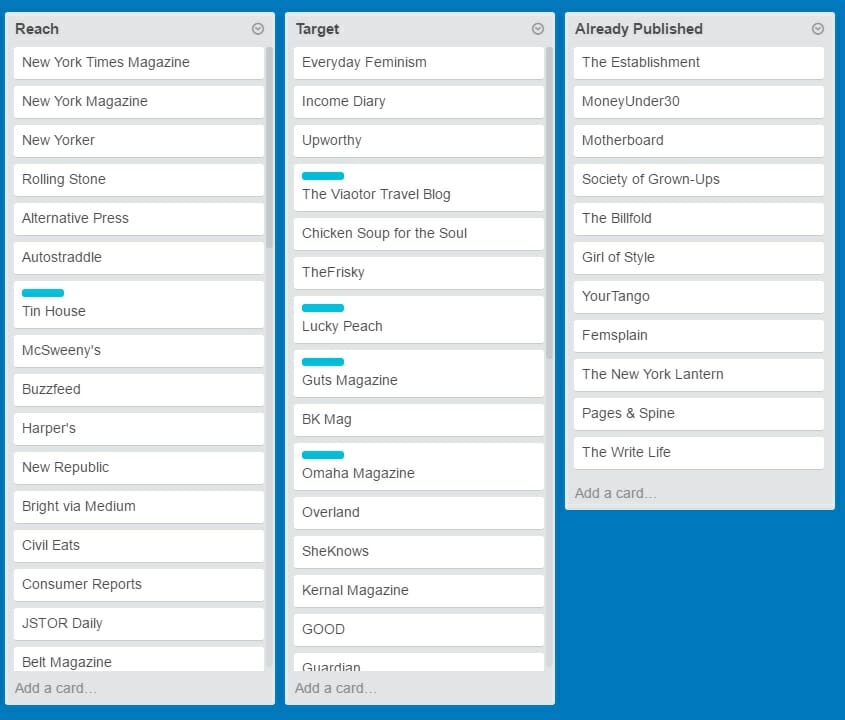During college, I wrote for free. I didn’t realize I could be compensated so early on in my writing career.
Once I graduated last summer, I committed to getting paid for my writing. That’s when I officially started my career as a freelance writer.
But I gradually noticed I was losing ideas.
I struggled to follow my pitches as they were accepted by email, and I quickly lost track of any feedback editors offered about my ideas.
I wrote down tons of ideas in a notebook, but felt uneasy about how quickly they could be forgotten.
My freelance writing resolution
As a New Year’s resolution, I vowed to find a better way to keep track of my pitches.
I searched the web for different ideas and asked dozens of other writers about their techniques: How do you do it? I started with a Google document for pitches, but it eventually got too long and tedious. There was too much information.
I transferred everything to a Google sheet, but I found myself getting frustrated over columns. I even started a pitch notebook with outlines and potential places I wanted to write for, but I lost myself within the pages.
Clearly, none of these methods worked for me.
But the right tools were already in front of me, and I didn’t even know it. At my day job, we use Trello, a web-based application originally created for project management — or as Trello describes itself, “a list of lists filled with cards.” Although my company subscribes to the premium version for a fee, I use a free account for my freelance ideas and assignments.
Here’s how I use Trello to keep track of my freelance projects.
Organizing ideas and pitches
To start, I have two freelance “boards”: Pitches and publications. On the pitches board, I track pitches from beginning to end. On the publications board, I track publications I want to write for and that I’ve written for the in past — but we’ll get to that one later on.

Whenever I think of an idea to pitch, I quickly add it to my “pitches” board as a single card in the “drafts” category. On the new card, I comment to add a draft pitch, along with potential publications to pitch it to.

Before pitching the post you’re reading, I used Trello to develop the idea. First, I created a Trello card called “How a freelance writer uses Trello” on my pitches board. On the card’s comments, I drafted a quick outline with a possible publication to pitch. My idea was rejected by my first outlet option before pitching to the Write Life, so in this case, the pitch didn’t develop as much it could have if I had continued to receive rejections or other feedback.
I also have columns for “drafts” and “back burner.” Drafts include any pitches I want to refine within the next few weeks, and back-burner includes any pitches I don’t intend on going back to for a while.
Additionally, I use labels “accepted,” “followed up,” “awaiting response,” and “timely” on cards. You can see the “How a freelance writer uses Trello” is green, which represents an accepted pitch.

Identifying target and reach publications
On another board, I track publications, organizing outlets I’d like to write for by “reach” and “target.” The reach list includes those I want to pitch to someday, but maybe not this year. The target list includes those I want to pitch sometime in the near future.
The “already published” list includes those I’ve written for already, and feel welcome to work with again. (The reach and target lists are so long, they’ve been cut off from this screenshot.)

Although I originally used this method to track pitches, I found it’s rewarding to also identify publications I want to write for in the future. Now, I have a better resource to consult when drafting pitches.
Before I started using Trello, I’d come across publications and tell myself, “Yeah, I want to write for them,” but would forget about them once I actually worked on a pitch. I never compiled a comprehensive list, especially one differentiated between target and reach publications, in a single place.
As a freelancer, it’s important to know the market and understand which publications are within your reach right now. I’d also argue my reach publications aren’t really that much of a reach. If I have a spectacular idea, I won’t restrict myself to only target publications.
Finally, I’ve found a successful way to manage my workflow.
With Trello, I’m a more-organized freelance writer than ever before. I have a better organization system for tracking pitches from start to finish, and I have a better understanding of which publications I can pitch when I start to develop an idea.
Have you developed a system to track ideas and pitches? Share it in the comments!







